
Crude oil exports from Canada by rail have broken record highs so far this year, according to data from the U.S. Energy Information Administration.
The major reason for the resurgence is that pipeline capacity to take oil sands output has been essentially filled, even as incremental production grows. More to the point, a big mining expansion is due to come into service by the end of this year, but no significant new pipeline capacity out of the region will be available until 2019. That leaves rail as the only way for producers to get molecules to market.
“There are several large unit-train loading facilities in Alberta,” said Sandy Fielden, director of oil and products research at analyst firm Morningstar Inc. “Those racks are not operating anywhere near capacity, so it does not seem that there will have to be any additional investment necessary.”
 That is good, Fielden said, because crude by rail is considered an interim solution for volumes large enough to attract pipeline investment; it remains an important adjunct, and access to extended markets.
That is good, Fielden said, because crude by rail is considered an interim solution for volumes large enough to attract pipeline investment; it remains an important adjunct, and access to extended markets.
Suncor and its partners Total and Teck Resources expect to have their Fort Hills project in service by the end of the year. In a statement, operating partner Suncor said “the project is scheduled to produce first oil by the end of fourth quarter of 2017 and achieve 90% of its planned production capacity of 194,000 barrels per day within 12 months. The mine life is expected to be approximately 50 years at the current planned production rate. The project is in
According to Morningstar, the Fort Hills bitumen will be shipped in a heated pipeline operated by TransCanada Corp. (NYSE: TRP) to Suncor’s East Tank farm at Fort McMurray, where it will be blended with condensate so that it can move through unheated pipelines. According to a presentation by Teck Resources, a 20% stakeholder in Fort Hills, the diluted bitumen, dilbit (75% bitumen, 25% condensate) will be shipped to
U.S. Development Group (USDG) signed a long-term producer customer committed to ship 30,000 barrels per day (Mbbl/d) of crude by rail from Hardisty to Cushing beginning in October.
“Given the timing of the transaction, we believe that customer is Teck Resources,” Morningstar said. “We base this on Teck Resources having leased 425,000 barrels of storage capacity owned by Gibsons Energy at Hardisty that is linked by pipeline to USDG’s rail terminal; and the absence of other new available pipeline capacity excluding Hardisty until the Enbridge Line 3 replacement is completed in 2019.”
At the other end of the pipe, USDG acquired the former EOG rail unloading terminal at Stroud, Okla., early in June for $25 million. According to USDG, “Our Stroud terminal is on 76-acres near the Cushing storage hub. The terminal includes unit train-capable unloading capacity of approximately 50,000 barrels per day, expandable to approximately 70,000 barrels per day, as well as two on-site tanks with approximately 140,000 barrels of total capacity and one truck bay.
“Inbound shipments are delivered by the Stillwater Central Rail, which handles deliveries from both the BNSF and the Union Pacific railways. Outbound shipments of crude are delivered via our 17-mile SCT Pipeline from the Stroud terminal to the Cushing storage hub. The Stroud terminal provides Western Canadian heavy barrels with access to multiple large, liquid markets, including the
While rail provides a quick answer to capacity, profitability remains a question. Morningstar ran the numbers and found that the current Enbridge pipeline tariff from Hardisty to Cushing for uncommitted “walk-up” heavy crude shippers is $8.57/bbl (the lowest tariff for a 10-year committed customer is $7.16/bbl). Rail shipping costs from Hardisty to Cushing or the Gulf Coast are not made public but are variously estimated by reporting services at between $12 and $15/bbl with additional terminal fees at both ends.
“Given the choice, shippers will use the pipeline option when capacity is available. Looking at the economics, it has made more sense recently for producers to sell crude at Hardisty than to ship to Cushing,” Morningstar said. “The Cushing premium for Western Canadian Select (WCS) increased throughout 2016 and early 2017 to peak at just under $8/barrel in March 2017. Since then, the Cushing premium has fallen in response to increased demand for WCS following a fire that shut down production at the Suncor syncrude plant and curtailed Canadian dilbit supplies. The current $4.50 WCS Cushing premium doesn't justify pipeline tariffs of $8.50/barrel let alone far higher rail costs. However, we expect the Cushing WCS premium over Hardisty to increase by the end of 2017 as the syncrude plant comes back on line and new production from Fort Hills comes on line.”
Recommended Reading
VTX Energy Quickly Ramps to 42,000 bbl/d in Southern Delaware Basin
2024-09-24 - VTX Energy’s founder was previously among the leadership that built and sold an adjacent southern Delaware operator, Brigham Resources, for $2.6 billion.
US Drillers Cut Oil, Gas Rigs for Third Week in a Row
2024-10-04 - The oil and gas rig count fell by two to 585 in the week to Oct. 4.
EY: How AI Can Transform Subsurface Operations
2024-10-10 - The inherent complexity of subsurface data and the need to make swift decisions demands a tailored approach.
Bowman Consulting to Manage, Monitor Delaware Basin Wells
2024-10-14 - Bowman Consulting Group’s scope of work includes conducting detailed field surveys of above-ground infrastructure assets across well sites of up to to 8 acres.
E&P Highlights: Oct. 7, 2024
2024-10-07 - Here’s a roundup of the latest E&P headlines, including a major announcement from BP and large contracts in the Middle East.
Comments
Add new comment
This conversation is moderated according to Hart Energy community rules. Please read the rules before joining the discussion. If you’re experiencing any technical problems, please contact our customer care team.





